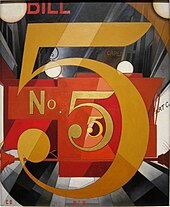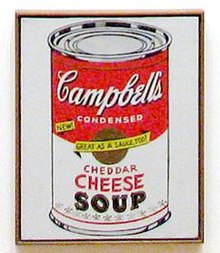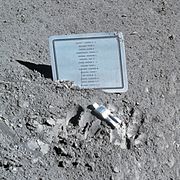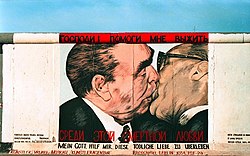Pop art

Pop art is an
Amongst the early artists that shaped the pop art movement were
Pop art often takes imagery that is currently in use in advertising. Product labeling and logos figure prominently in the imagery chosen by pop artists, seen in the labels of Campbell's Soup Cans, by Andy Warhol. Even the labeling on the outside of a shipping box containing food items for retail has been used as subject matter in pop art, as demonstrated by Warhol's Campbell's Tomato Juice Box, 1964 (pictured).
Origins

The origins of pop art in North America developed differently from those in Great Britain.
By contrast, the origins of pop art in
Proto-pop
Although both British and American pop art began during the 1950s,
United Kingdom: the Independent Group

The
According to the son of John McHale, the term "pop art" was first coined by his father in 1954 in conversation with Frank Cordell,[12] although other sources credit its origin to British critic Lawrence Alloway.[13][14] (Both versions agree that the term was used in Independent Group discussions by mid-1955.)
"Pop art" as a moniker was then used in discussions by IG members in the Second Session of the IG in 1955, and the specific term "pop art" first appeared in published print in the article "But Today We Collect Ads" by IG members Alison and Peter Smithson in Ark magazine in 1956.[15] However, the term is often credited to British art critic/curator Lawrence Alloway for his 1958 essay titled The Arts and the Mass Media, even though the precise language he uses is "popular mass culture".[16] "Furthermore, what I meant by it then is not what it means now. I used the term, and also 'Pop Culture' to refer to the products of the mass media, not to works of art that draw upon popular culture. In any case, sometime between the winter of 1954–55 and 1957 the phrase acquired currency in conversation..."[17] Nevertheless, Alloway was one of the leading critics to defend the inclusion of the imagery of mass culture in the fine arts. Alloway clarified these terms in 1966, at which time Pop Art had already transited from art schools and small galleries to a major force in the artworld. But its success had not been in England. Practically simultaneously, and independently, New York City had become the hotbed for Pop Art.[17]
In London, the annual
United States
Although pop art began in the early 1950s, in America it was given its greatest impetus during the 1960s. The term "pop art" was officially introduced in December 1962; the occasion was a "Symposium on Pop Art" organized by the Museum of Modern Art.[19] By this time, American advertising had adopted many elements of modern art and functioned at a very sophisticated level. Consequently, American artists had to search deeper for dramatic styles that would distance art from the well-designed and clever commercial materials.[6] As the British viewed American popular culture imagery from a somewhat removed perspective, their views were often instilled with romantic, sentimental and humorous overtones. By contrast, American artists, bombarded every day with the diversity of mass-produced imagery, produced work that was generally more bold and aggressive.[10]
According to historian, curator and critic
Indeed, two other important artists in the establishment of America's pop art vocabulary were the painters Jasper Johns and Robert Rauschenberg.[10] Rauschenberg, who like Ray Johnson attended Black Mountain College in North Carolina after World War II, was influenced by the earlier work of Kurt Schwitters and other Dada artists, and his belief that "painting relates to both art and life" challenged the dominant modernist perspective of his time.[24] His use of discarded readymade objects (in his Combines) and pop culture imagery (in his silkscreen paintings) connected his works to topical events in everyday America.[10][25][26] The silkscreen paintings of 1962–64 combined expressive brushwork with silkscreened magazine clippings from Life, Newsweek, and National Geographic. Johns' paintings of flags, targets, numbers, and maps of the U.S. as well three-dimensional depictions of ale cans drew attention to questions of representation in art.[27] Johns' and Rauschenberg's work of the 1950s is frequently referred to as Neo-Dada, and is visually distinct from the prototypical American pop art which exploded in the early 1960s.[28][29]
The paintings of Lichtenstein, like those of Andy Warhol, Tom Wesselmann and others, share a direct attachment to the commonplace image of American popular culture, but also treat the subject in an impersonal manner clearly illustrating the idealization of mass production.[10]
Andy Warhol is probably the most famous figure in pop art. In fact, art critic Arthur Danto once called Warhol "the nearest thing to a philosophical genius the history of art has produced".[19] Warhol attempted to take pop beyond an artistic style to a life style, and his work often displays a lack of human affectation that dispenses with the irony and parody of many of his peers.[32][33]
Early U.S. exhibitions

Donald Factor, the son of Max Factor Jr., and an art collector and co-editor of avant-garde literary magazine Nomad, wrote an essay in the magazine's last issue, Nomad/New York. The essay was one of the first on what would become known as pop art, though Factor did not use the term. The essay, "Four Artists", focused on Roy Lichtenstein, James Rosenquist, Jim Dine, and Claes Oldenburg.[36]
In the 1960s, Oldenburg, who became associated with the pop art movement, created many happenings, which were performance art-related productions of that time. The name he gave to his own productions was "Ray Gun Theater". The cast of colleagues in his performances included: artists Lucas Samaras, Tom Wesselmann, Carolee Schneemann, Öyvind Fahlström and Richard Artschwager; dealer Annina Nosei; art critic Barbara Rose; and screenwriter Rudy Wurlitzer.[37] His first wife, Patty Mucha, who sewed many of his early soft sculptures, was a constant performer in his happenings. This brash, often humorous, approach to art was at great odds with the prevailing sensibility that, by its nature, art dealt with "profound" expressions or ideas. In December 1961, he rented a store on Manhattan's Lower East Side to house The Store, a month-long installation he had first presented at the Martha Jackson Gallery in New York, stocked with sculptures roughly in the form of consumer goods.[37]
Opening in 1962,
A bit earlier, on the
By 1962, pop artists started exhibiting in commercial galleries in New York and Los Angeles; for some, it was their first commercial one-man show. The
In 1968, the São Paulo 9 Exhibition – Environment U.S.A.: 1957–1967 featured the "Who's Who" of pop art. Considered as a summation of the classical phase of the American pop art period, the exhibit was curated by William Seitz. The artists were Edward Hopper, James Gill, Robert Indiana, Jasper Johns, Roy Lichtenstein, Claes Oldenburg, Robert Rauschenberg, Andy Warhol and Tom Wesselmann.[43]
France
Contemporary of American Pop Art—often conceived as its transposition in France—new realism was along with
Spain
In Spain, the study of pop art is associated with the "new figurative", which arose from the roots of the crisis of informalism. Eduardo Arroyo could be said to fit within the pop art trend, on account of his interest in the environment, his critique of our media culture which incorporates icons of both mass media communication and the history of painting, and his scorn for nearly all established artistic styles. However, the Spanish artist who could be considered most authentically part of "pop" art is Alfredo Alcaín, because of the use he makes of popular images and empty spaces in his compositions.[citation needed]
Also in the category of Spanish pop art is the "Chronicle Team" (El Equipo Crónica), which existed in
New Zealand

In New Zealand, pop art has predominately flourished since the 1990s, and is often connected to
This can be also done in an abrasive and deadpan way, as with Michel Tuffrey's famous work Pisupo Lua Afe (Corned Beef 2000). Of Samoan ancestry, Tuffery constructed the work, which represents a bull, out of processed food cans known as pisupo. It is a unique work of western pop art because Tuffrey includes themes of neocolonialism and racism against non-western cultures (signified by the food cans the work is made of, which represent economic dependence brought on Samoans by the west). The undeniable indigenous viewpoint makes it stand out against more common non-indigenous works of pop art.[50][51]
One of New Zealand's earliest and famous pop artists is Billy Apple, one of the few non-British members of the Royal Society of British Artists. Featured among the likes of David Hockney, American R.B. Kitaj and Peter Blake in the January 1961 RBA exhibition Young Contemporaries, Apple quickly became an iconic international artist of the 1960s. This was before he conceived his moniker of "Billy Apple", and his work was displayed under his birth name of Barrie Bates. He sought to distinguish himself by appearance as well as name, so bleached his hair and eyebrows with Lady Clairol Instant Creme Whip. Later, Apple was associated with the 1970s Conceptual Art movement.[52]
Japan
In Japan, pop art evolved from the nation's prominent avant-garde scene. The use of images of the modern world, copied from magazines in the photomontage-style paintings produced by Harue Koga in the late 1920s and early 1930s, foreshadowed elements of pop art.[53] The Japanese Gutai movement led to a 1958 Gutai exhibition at Martha Jackson's New York gallery that preceded by two years her famous New Forms New Media show that put Pop Art on the map.[54] The work of Yayoi Kusama contributed to the development of pop art and influenced many other artists, including Andy Warhol.[55][56] In the mid-1960s, graphic designer Tadanori Yokoo became one of the most successful pop artists and an international symbol for Japanese pop art. He is well known for his advertisements and creating artwork for pop culture icons such as commissions from The Beatles, Marilyn Monroe, and Elizabeth Taylor, among others.[57] Another leading pop artist at that time was Keiichi Tanaami. Iconic characters from Japanese manga and anime have also become symbols for pop art, such as Speed Racer and Astro Boy. Japanese manga and anime also influenced later pop artists such as Takashi Murakami and his superflat movement.
Italy

In Italy, by 1964 pop art was known and took different forms, such as the "Scuola di Piazza del Popolo" in Rome, with pop artists such as Mario Schifano, Franco Angeli, Giosetta Fioroni, Tano Festa, Claudio Cintoli, and some artworks by Piero Manzoni, Lucio Del Pezzo, Mimmo Rotella and Valerio Adami.
Italian pop art originated in 1950s culture – the works of the artists Enrico Baj and Mimmo Rotella to be precise, rightly considered the forerunners of this scene. In fact, it was around 1958–1959 that Baj and Rotella abandoned their previous careers (which might be generically defined as belonging to a non-representational genre, despite being thoroughly post-Dadaist), to catapult themselves into a new world of images, and the reflections on them, which was springing up all around them. Rotella's torn posters showed an ever more figurative taste, often explicitly and deliberately referring to the great icons of the times. Baj's compositions were steeped in contemporary kitsch, which turned out to be a "gold mine" of images and the stimulus for an entire generation of artists.
The novelty came from the new visual panorama, both inside "domestic walls" and out-of-doors. Cars, road signs, television, all the "new world", everything can belong to the world of art, which itself is new. In this respect, Italian pop art takes the same ideological path as that of the international scene. The only thing that changes is the iconography and, in some cases, the presence of a more critical attitude toward it. Even in this case, the prototypes can be traced back to the works of Rotella and Baj, both far from neutral in their relationship with society. Yet this is not an exclusive element; there is a long line of artists, including Gianni Ruffi, Roberto Barni, Silvio Pasotti, Umberto Bignardi, and Claudio Cintoli, who take on reality as a toy, as a great pool of imagery from which to draw material with disenchantment and frivolity, questioning the traditional linguistic role models with a renewed spirit of "let me have fun" à la Aldo Palazzeschi.[58]

Belgium
In
Netherlands
While there was no formal pop art movement in the
Russia

Notable artists
- Billy Apple (1935–2021)
- Evelyne Axell (1935–1972)
- Sir Peter Blake (born 1932)
- Derek Boshier (born 1937)
- Pauline Boty (1938–1966)
- Patrick Caulfield (1936–2005)
- Allan D'Arcangelo (1930–1998)
- Jim Dine (born 1935)
- Burhan Dogancay(1929–2013)
- Robert Dowd (1936–1996)
- Rosalyn Drexler (born 1926)
- Ken Elias (born 1944)
- Erró (born 1932)
- Marisol Escobar (1930–2016)
- James Gill (born 1934)
- Dorothy Grebenak (1913–1990)
- Red Grooms (born 1937)
- Richard Hamilton (1922–2011)
- Keith Haring (1958–1990)
- Jann Haworth (born 1942)
- David Hockney (born 1937)
- Dorothy Iannone (1933–2022)
- Robert Indiana (1928–2018)
- Jasper Johns (born 1930)
- Ray Johnson (1927–1995)
- Allen Jones(born 1937)
- Alex Katz (born 1927)
- Corita Kent (1918–1986)
- Konrad Klapheck (1935–2023)
- Kiki Kogelnik (1935–1997)
- Nicholas Krushenick (1929–1999)
- Yayoi Kusama (born 1929)
- Gerald Laing (1936–2011)
- Roy Lichtenstein (1923–1997)
- Richard Lindner (1901–1978)
- Peter Max (born 1937)
- John McHale (1922–1978)
- Marta Minujin(born 1943)
- Claes Oldenburg (1929-2022)
- Don Nice (1932–2019)
- Julian Opie (born 1958)
- Eduardo Paolozzi (1924–2005)
- Peter Phillips (born 1939)
- Sigmar Polke (1941–2010)
- Hariton Pushwagner (1940–2018)
- Mel Ramos (1935–2018)
- Robert Rauschenberg (1925–2008)
- Larry Rivers (1923–2002)
- James Rizzi (1950–2011)
- James Rosenquist (1933–2017)
- Niki de Saint Phalle (1930–2002)
- Peter Saul (born 1934)
- George Segal (1924–2000)
- Colin Self (born 1941)
- Marjorie Strider (1931–2014)
- Elaine Sturtevant (1924–2014)
- Wayne Thiebaud (1920–2021)
- Joe Tilson (born 1928)
- Andy Warhol (1928–1987)
- Idelle Weber (1932–2020)
- John Wesley (1928-2022)
- Tom Wesselmann (1931–2004)
See also
References
- ^ Pop Art: A Brief History, MoMA Learning
- ^ a b c d e Livingstone, M., Pop Art: A Continuing History, New York: Harry N. Abrams, Inc., 1990
- ^ a b c de la Croix, H.; Tansey, R., Gardner's Art Through the Ages, New York: Harcourt Brace Jovanovich, Inc., 1980.
- ^ ISBN 0-7537-0179-0, p486-487.
- ^ Harrison, Sylvia (27 August 2001). Pop Art and the Origins of Post-Modernism. Cambridge University Press.
- ^ a b c d Gopnik, A.; Varnedoe, K., High & Low: Modern Art & Popular Culture, New York: The Museum of Modern Art, 1990
- ^ "History, Travel, Arts, Science, People, Places | Smithsonian". Smithsonianmag.com. Retrieved 30 December 2015.
- ^ "Modern Love". The New Yorker. 6 August 2007. Retrieved 30 December 2015.
- ^ Wayne Craven, American Art: History and . p.464.
- ^ a b c d e f g Arnason, H., History of Modern Art: Painting, Sculpture, Architecture, New York: Harry N. Abrams, Inc. 1968.
- ^ "'I was a Rich Man's Plaything', Sir Eduardo Paolozzi". Tate. 10 December 2015. Retrieved 30 December 2015.
- ^ "John McHale". Warholstars.org. Retrieved 30 December 2015.
- ^ "Pop art", A Dictionary of Twentieth-Century Art, Ian Chilvers. Oxford University Press, 1998.
- ^ "Pop art", The Concise Oxford Dictionary of Art Terms, Michael Clarke, Oxford University Press, 2001.
- ISBN 0-262-73081-2
- ^ Lawrence Alloway, "The Arts and the Mass Media," Architectural Design & Construction, February 1958.
- ^ ISBN 3822822183
- ^ ISBN 978-0-9558367-3-2.
- ^ a b c d Scherman, Tony. "When Pop Turned the Art World Upside Down." American Heritage 52.1 (February 2001), 68.
- ^ Geldzahler, Henry in Pop Art: 1955–1970 catalogue, Art Gallery of New South Wales, Sydney, 1985
- ^ Lippard, Lucy in Ray Johnson: Correspondences catalogue, Wexner Center/Whitney Museum, 2000
- ^ Bloch, Mark. "An Illustrated Introduction to Ray Johnson 1927–1995", 1995
- ^ Author unknown. "(Table of contents, Untitled note about cover.)", Art News, vol. 56, no. 9, January 1958
- OCLC748990996. "Painting relates to both art and life. Neither can be made. (I try to act in that gap between the two.)"
- ISSN 0040-781X. Retrieved 7 July 2020.
Robert Rauschenberg, 37, remembers an art teacher who 'taught me to think, "Why not?"' Since Rauschenberg is considered to be a pioneer in pop art, this is probably where the movement went off on its particular tangent. Why not make art out of old newspapers, bits of clothing, Coke bottles, books, skates, clocks?
- ISBN 0-06-438505-1pp. 174–195, Rauschenberg and Johns; pp. 103–111, Rivers and the gestural realists.
- ^ Rosenthal, Nan (October 2004). "Jasper Johns (born 1930) In Heilbrunn Timeline of Art History". The Metropolitan Museum of Art. Retrieved 2 May 2021.
- ^ Robert Rosenblum, "Jasper Johns" Art International (September 1960): 75.
- ^ Hapgood, Susan, Neo-Dada: Redefining Art, 1958–62. New York: Universe Books, 1994.
- ISBN 3-8228-0281-6.
- ^ Kimmelman, Michael (30 September 1997). "Roy Lichtenstein, Pop Master, Dies at 73". The New York Times. Retrieved 12 November 2007.
- ^ Michelson, Annette, Buchloh, B. H. D. (eds) Andy Warhol (October Files), MIT Press, 2001.
- ^ Warhol, Andy. The Philosophy of Andy Warhol, from A to B and back again. Harcourt Brace Jovanovich, 1975
- ^ "The Collection". MoMA.org. Retrieved 30 December 2015.
- ^ "The Great American Pop Art Store: Multiples of the Sixties". Tfaoi.com. Retrieved 30 December 2015.
- ^ Diggory (2013).
- ^ a b Kristine McKenna (2 July 1995), When Bigger Is Better: Claes Oldenburg has spent the past 35 years blowing up and redefining everyday objects, all in the name of getting art off its pedestal Los Angeles Times.
- ISBN 9780226904931. Retrieved 30 December 2015.
- ^ "Museum History » Norton Simon Museum". Nortonsimon.org. Retrieved 30 December 2015.
- OCLC 360205683.
- ^ Gayford, Martin (19 December 2002). "Still life at the check-out". The Telegraph. Telegraph Media Group Ltd. Archived from the original on 11 January 2022. Retrieved 28 November 2012.
- ISBN 1-155-48349-9.
- ^ Jim Edwards, William Emboden, David McCarthy: Uncommonplaces: The Art of James Francis Gill, 2005, p.54
- ISBN 3-8228-5907-9
- ^ ISBN 3-8228-2942-0
- ^ Rosemary M. O'Neill, Art and Visual Culture on the French Riviera, 1956–1971: The Ecole de Nice, Ashgate, 2012, p. 93.
- ^ 60/90. Trente ans de Nouveau Réalisme, La Différence, 1990, p. 76
- ^ "Op + Pop". christchurchartgallery.org.nz. Retrieved 22 July 2021.
- ^ "Dick Frizzell – Overview". The Central. Retrieved 22 July 2021.
- ^ "Loading... | Collections Online – Museum of New Zealand Te Papa Tongarewa". collections.tepapa.govt.nz. Retrieved 22 July 2021.
- ^ "Loading... | Collections Online – Museum of New Zealand Te Papa Tongarewa". collections.tepapa.govt.nz. Retrieved 22 July 2021.
- ^ "ARTSPACE – Billy Apple". 9 February 2013. Archived from the original on 9 February 2013. Retrieved 29 July 2021.
- ^ Eskola, Jack (2015). Harue Koga: David Bowie of the Early 20th Century Japanese Art Avant-garde. Kindle, e-book.
- ^ Bloch, Mark. The Brooklyn Rail. "Gutai: 1953 –1959", June 2018.
- ^ "Yayoi Kusama interview – Yayoi Kusama exhibition". Timeout.com. 30 January 2013. Retrieved 30 December 2015.
- ^ [1] Archived 1 November 2012 at the Wayback Machine
- ^ "Tadanori Yokoo : ADC • Global Awards & Club". Adcglobal.org. 27 June 1936. Retrieved 30 December 2015.
- ^ "Pop Art Italia 1958–1968 — Galleria Civica". Comune.modena.it. Retrieved 30 December 2015.
- ^ "Philadelphia Museum of Art Wins Fight with Facebook over Racy Pop Art Painting". artnet.com. 11 February 2016. Retrieved 17 January 2020.
- ^ "Dutch Pop Art & The Sixties – Weg met de vertrutting!". 8weekly.nl. 28 July 2005. Retrieved 30 December 2015.
- ^ [2] Archived 7 June 2013 at the Wayback Machine
Further reading
- Bloch, Mark. The Brooklyn Rail. "Gutai: 1953 –1959", June 2018.
- Diggory, Terence (2013) Encyclopedia of the New York School Poets (Facts on File Library of American Literature). ISBN 978-1-4381-4066-7
- Francis, Mark and Foster, Hal (2010) Pop. London and New York: Phaidon.
- Haskell, Barbara (1984) BLAM! The Explosion of Pop, Minimalism and Performance 1958–1964. New York: W.W. Norton & Company, Inc. in association with the Whitney Museum of American Art.
- Lifshitz, Mikhail, The Crisis of Ugliness: From Cubism to Pop-Art. Translated and with an Introduction by David Riff. Leiden: BRILL, 2018 (originally published in Russian by Iskusstvo, 1968).
- Lippard, Lucy R. (1966) Pop Art, with contributions by Lawrence Alloway, Nancy Marmer, Nicolas Calas, Frederick A. Praeger, New York.
- Selz, Peter (moderator); Ashton, Dore; Geldzahler, Henry; Kramer, Hilton; Kunitz, Stanley and Steinberg, Leo (April 1963) "A symposium on Pop Art" Arts Magazine, pp. 36–45. Transcript of symposium held at the Museum of Modern Art on 13 December 1962.
